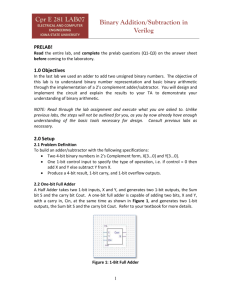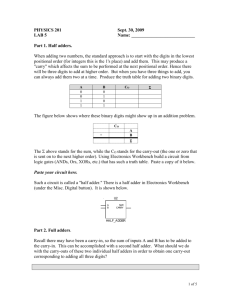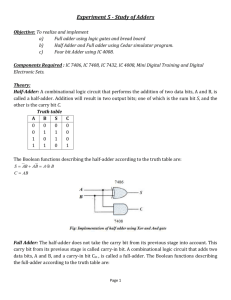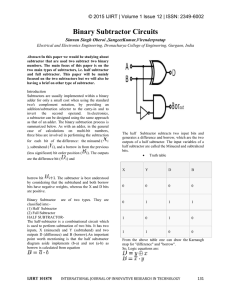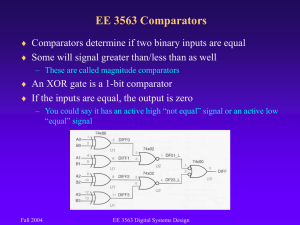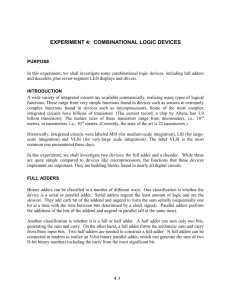Parallel Binary Adders
advertisement
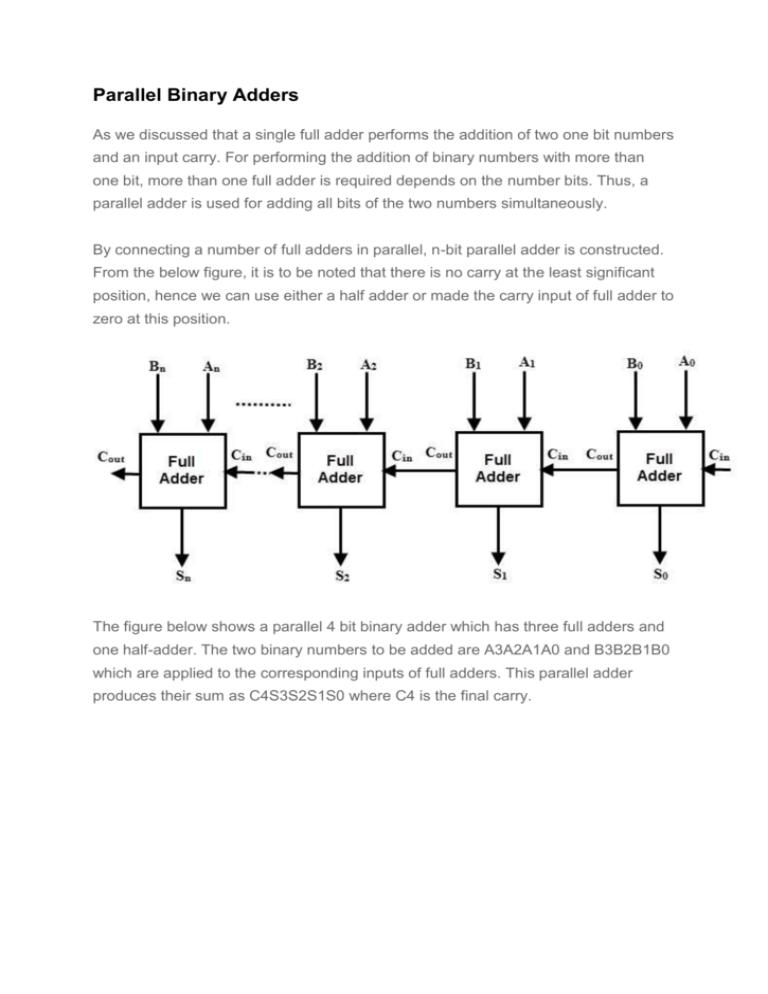
Parallel Binary Adders As we discussed that a single full adder performs the addition of two one bit numbers and an input carry. For performing the addition of binary numbers with more than one bit, more than one full adder is required depends on the number bits. Thus, a parallel adder is used for adding all bits of the two numbers simultaneously. By connecting a number of full adders in parallel, n-bit parallel adder is constructed. From the below figure, it is to be noted that there is no carry at the least significant position, hence we can use either a half adder or made the carry input of full adder to zero at this position. The figure below shows a parallel 4 bit binary adder which has three full adders and one half-adder. The two binary numbers to be added are A3A2A1A0 and B3B2B1B0 which are applied to the corresponding inputs of full adders. This parallel adder produces their sum as C4S3S2S1S0 where C4 is the final carry. In the 4 bit adder, first block is a half-adder that has two inputs as A0B0 and produces their sum S0 and a carry bit C1. Next block should be full adder as there are three inputs applied to it. Hence this full adder produces their sum S1 and a carry C2. This will be followed by other two full adders and thus the final sum is C4S3S2S1S0. Most commonly Full adders designed in dual in-line package integrated circuits. A typical 74LS283 is a 4 bit full adder. Arithmetic and Logic Unit of a unit computer consist of these parallel adders to perform the addition of binary numbers. Parallel Binary Subtractors To perform the subtraction of binary numbers with more than one bit is performed through the parallel subtractors. This parallel subtractor can be designed in several ways, including combination of half and full subtractors, all full subtractors, all full adders with subtrahend complement input, etc. The below figure shows a 4 bit parallel binary subtractor formed by connecting one half subtractor and three full subtractors. In this subtractor, 4 bit minuend A3A2A1A0 is subtracted by 4 bit subtrahend B3B2B1B0 and gives the difference output D3D2D1D0. The borrow output of each subtractor is connected as the borrow input to the next preceding subtractor. It is also possible to design a 4 bit parallel subtractor 4 full adders as shown in the below figure. This circuit performs the subtraction operation by considering the principle that the addition of minuend and the complement of the subtrahend is equivalent to the subtraction process. We know that the subtraction of A by B is obtained by taking 2’s complement of B and adding it to A. The 2’s complement of B is obtained by taking 1’s complement and adding 1 to the least significant pair of bits. Hence, in this circuit 1’s complement of B is obtained with the inverters (NOT gate) and a 1 can be added to the sum through the input carry. Back to top Parallel Adder / Subtractor The operations of both addition and subtraction can be performed by a one common binary adder. Such binary circuit can be designed by adding an Ex-OR gate with each full adder as shown in below figure. The figure below shows the 4 bit parallel binary adder/subtractor which has two 4 bit inputs as A3A2A1A0 and B3B2B1B0. The mode input control line M is connected with carry input of the least significant bit of the full adder. This control line decides the type of operation, whether addition or subtraction. When M= 1, the circuit is a subtractor and when M=0, the circuit becomes adder. The Ex-OR gate consists of two inputs to which one is connected to the B and other to input M. When M = 0, B Ex-OR of 0 produce B. Then full adders add the B with A with carry input zero and hence an addition operation is performed. When M = 1, B Ex-OR of 0 produce B complement and also carry input is 1. Hence the complemented B inputs are added to A and 1 is added through the input carry, nothing but a 2’s complement operation. Therefore, the subtraction operation is performed.


